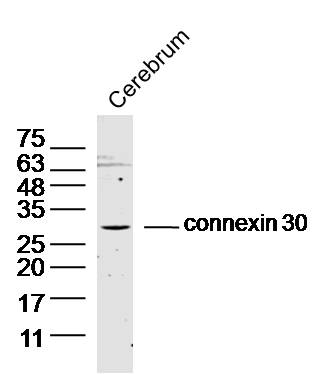
Rabbit Anti-connexin 30 antibody
Connexin 30; Connexin-30; Cx30; CXB6_HUMAN; DFNA3; ectodermal dysplasia 2, hidrotic (Clouston syndrome); ED2; EDH; Gap junction beta 6 protein; Gap junction beta-6 protein; gap junction protein, beta 6 (connexin 30); gap junction protein, beta 6; GJB6; HE
View History [Clear]
Details
Product Name connexin 30 Chinese Name 间隙连接蛋白30/GJB6抗体 Alias Connexin 30; Connexin-30; Cx30; CXB6_HUMAN; DFNA3; ectodermal dysplasia 2, hidrotic (Clouston syndrome); ED2; EDH; Gap junction beta 6 protein; Gap junction beta-6 protein; gap junction protein, beta 6 (connexin 30); gap junction protein, beta 6; GJB6; HED; NSRD1. Research Area Cell biology Neurobiology Signal transduction Cell adhesion molecule Immunogen Species Rabbit Clonality Polyclonal React Species Mouse, (predicted: Human, Rat, Cow, Horse, Rabbit, Sheep, ) Applications WB=1:500-2000 IHC-P=1:100-500 IHC-F=1:100-500 ICC=1:100-500 IF=1:100-500 (Paraffin sections need antigen repair)
not yet tested in other applications.
optimal dilutions/concentrations should be determined by the end user.Theoretical molecular weight 29kDa Cellular localization The cell membrane Form Liquid Concentration 1mg/ml immunogen KLH conjugated synthetic peptide derived from human connexin-30: 201-261/261 <Cytoplasmic> Lsotype IgG Purification affinity purified by Protein A Buffer Solution 0.01M TBS(pH7.4) with 1% BSA, 0.03% Proclin300 and 50% Glycerol. Storage Shipped at 4℃. Store at -20 °C for one year. Avoid repeated freeze/thaw cycles. Attention This product as supplied is intended for research use only, not for use in human, therapeutic or diagnostic applications. PubMed PubMed Product Detail The connexin family of proteins form hexameric complexes called connexons that facilitate movement of low molecular weight proteins between cells via gap junctions. Connexin proteins share a common topology of four transmembrane alpha-helical domains, two extracellular loops, a cytoplasmic loop and cytoplasmic N- and C-termini. Many of the key functional differences between connexins arise from specific amino-acid substitutions in the most highly conserved domains: the transmembrane and extracellular regions. Connexin 30, also known as GJB6 (Gap junction beta 6), ED2, EDH, HED or DFNA3, is a 261 amino acid multi-pass membrane protein that localizes to the cell junction and belongs to the connexin family. Functioning as a hexamer with other connexin proteins, connexin 30 facilitates the diffusion of low molecular weight materials from one cell to another. Defects in the gene encoding connexin 30 are the cause of ectodermal dysplasia type 2 (ED2) and non-syndromatic sensorineural deafness autosomal dominant type 3 (DFNA3), the former of which is characterized by abnormal development of ectodermal structures (such as skin and nails).
Function:
One gap junction consists of a cluster of closely packed pairs of transmembrane channels, the connexons, through which materials of low MW diffuse from one cell to a neighboring cell.
Subunit:
A connexon is composed of a hexamer of connexins. Interacts with CNST
Subcellular Location:
Cell membrane; Multi-pass membrane protein. Cell junction, gap junction.
DISEASE:
Defects in GJB6 are the cause of ectodermal dysplasia type 2 (ED2) [MIM:129500]; also known as Clouston syndrome. Ectodermal dysplasia defines a heterogeneous group of disorders due to abnormal development of two or more ectodermal structures. ED2 is an autosomal dominant condition characterized by atrichosis, nail hypoplasia and deformities, hyperpigmentation of the skin, normal teeth, normal sweat and sebaceous gland function. Palmoplantar hyperkeratosis is a frequent features. Hearing impairment has been detected in few cases of ED2.
Defects in GJB6 are the cause of deafness autosomal recessive type 1B (DFNB1B) [MIM:612645]. DFNB1B is a form of sensorineural hearing loss. Sensorineural deafness results from damage to the neural receptors of the inner ear, the nerve pathways to the brain, or the area of the brain that receives sound information.
Defects in GJB6 are the cause of deafness autosomal dominant type 3B (DFNA3B) [MIM:612643].
Similarity:
Belongs to the connexin family. Beta-type (group I) subfamily.
SWISS:
O95452
Gene ID:
10804
Database links:Entrez Gene: 10804 Human
Entrez Gene: 14623 Mouse
SwissProt: O95452 Human
SwissProt: P70689 Mouse
Product Picture
References (0)
No References
Bought notes(bought amounts latest0)
No one bought this product
User Comment(Total0User Comment Num)
- No comment



 +86 571 56623320
+86 571 56623320
 +86 18668110335
+86 18668110335

